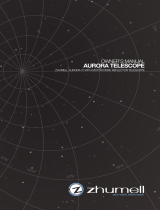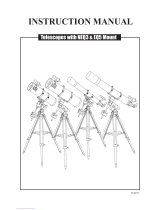Celestron 21077 Refractor Telescope User manual
- Category
- Telescopes
- Type
- User manual
Celestron 21077 Refractor Telescope: With its 80mm aperture and 910mm focal length, this telescope is perfect for lunar and planetary viewing, as well as deep-sky objects like galaxies and nebulae. The C80-HD features a sturdy equatorial mount that allows for smooth and precise tracking of celestial objects. It comes with a 20mm Plossl eyepiece that provides a magnification of 45x, and a 1 ¼" mirror diagonal for comfortable viewing. Beginners and experienced astronomers alike will find the C80-HD an excellent choice for exploring the night sky.
Celestron 21077 Refractor Telescope: With its 80mm aperture and 910mm focal length, this telescope is perfect for lunar and planetary viewing, as well as deep-sky objects like galaxies and nebulae. The C80-HD features a sturdy equatorial mount that allows for smooth and precise tracking of celestial objects. It comes with a 20mm Plossl eyepiece that provides a magnification of 45x, and a 1 ¼" mirror diagonal for comfortable viewing. Beginners and experienced astronomers alike will find the C80-HD an excellent choice for exploring the night sky.

















-
 1
1
-
 2
2
-
 3
3
-
 4
4
-
 5
5
-
 6
6
-
 7
7
-
 8
8
-
 9
9
-
 10
10
-
 11
11
-
 12
12
-
 13
13
-
 14
14
-
 15
15
-
 16
16
-
 17
17
Celestron 21077 Refractor Telescope User manual
- Category
- Telescopes
- Type
- User manual
Celestron 21077 Refractor Telescope: With its 80mm aperture and 910mm focal length, this telescope is perfect for lunar and planetary viewing, as well as deep-sky objects like galaxies and nebulae. The C80-HD features a sturdy equatorial mount that allows for smooth and precise tracking of celestial objects. It comes with a 20mm Plossl eyepiece that provides a magnification of 45x, and a 1 ¼" mirror diagonal for comfortable viewing. Beginners and experienced astronomers alike will find the C80-HD an excellent choice for exploring the night sky.
Ask a question and I''ll find the answer in the document
Finding information in a document is now easier with AI
Related papers
-
Celestron 91510 User manual
-
Celestron Omni XLT User manual
-
Celestron XLT Series User manual
-
Celestron 93517 User manual
-
Celestron Astro Master 130eq Owner's manual
-
Celestron 21062 Owner's manual
-
Celestron 127 User manual
-
Celestron 21072 User manual
-
Celestron 21072 User manual
-
Celestron CGEM 925 Owner's manual
Other documents
-
 Zhumell AURORA 70 Owner's manual
Zhumell AURORA 70 Owner's manual
-
iOptron #6002 Owner's manual
-
Levenhuk Skyline PRO 90 MAK User manual
-
Zhumell ECLIPSE 114 User manual
-
 Sky-Watcher NEQ3 User manual
Sky-Watcher NEQ3 User manual
-
APM SK P25012EQ6-2IN User manual
-
Meade 60EQ-D User manual
-
Orion Sirius EQ?G User manual
-
Orion ATLAS EQ-G User manual
-
ORION TELESCOPES & BINOCULARS SkyView Pro 120 EQ 9867 User manual


















